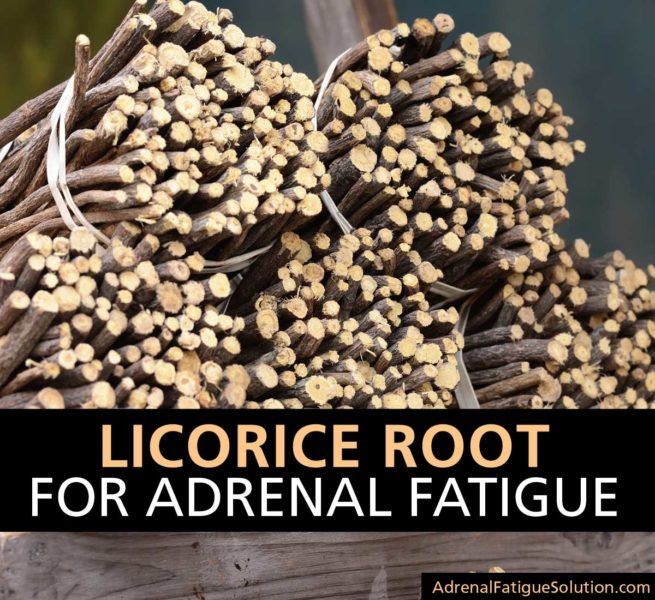Most of us only of know licorice as a sweet black candy. You may be surprised to know that licorice is actually a highly therapeutic herb that has been used in traditional medicine for centuries. In fact, most commercially-available licorice candy doesn’t contain any ‘real’ licorice at all – just the flavor!
The licorice plant grows throughout Europe, Asia and the Mediterranean. The root is the part most often used for medicinal purposes, and is generally made into a tincture or dried into a tea.
Licorice root boasts a huge variety of therapeutic properties. It’s a proven anti-inflammatory and immune booster, and has been used to treat a range of conditions including asthma, coughs, heartburn, viral or fungal infections, ulcers, psoriasis, sore throat, tendinitis, arthritis, and yeast infections.
But it’s licorice’s adaptogenic properties that make it a potential lifesaver for those suffering from adrenal fatigue. An adaptogenic herb is one that supports the adrenal glands and helps the body manage stress. Research has found that licorice can help to modify or even increase the body’s levels of cortisol. This means that licorice may be an effective treatment for those suffering from sub-optimal cortisol production, such as in the case of adrenal fatigue.
How Licorice Root Works
Licorice contains a powerful compound called glycyrrhizic acid. It’s this acid that stops the body from breaking down cortisol. Cortisol is the ‘stress hormone’ made by the adrenal glands and released when the body is under mental and physical pressure. Low levels of cortisol are associated with adrenal fatigue syndrome, and can lead to feelings of tiredness, mood swings and poor immune function.
Licorice root may be particularly beneficial for those suffering from adrenal fatigue, as it’s been shown to prevent the body from “using up” its stores of cortisol. It does this by reducing conversion of cortisol to inactive cortisone in the kidneys, which has the effect of increasing the availability of cortisol in the body. Glycyrrhizic acid is therefore said to boost adrenal gland function, which in turn enhances stress resistance.
This study found that licorice root can modify the production of cortisol in the body by inhibiting the enzymes that break cortisol down into cortisone, thus rendering it inactive. When a group of men and women were given a supplement of licorice extract for one week, each of the participants showed increased DHEA levels. Their cortisol levels also increased, suggesting that licorice extract works very quickly and effectively.
Other Benefits of Licorice Root
When used in the right amount at the right time, licorice root can effectively treat a number of conditions, including:
- Constipation: Licorice is an effective laxative, lubricating mucous membranes.
- Peptic ulcers: Licorice is a demulcent, helping to soothe inflamed tissue.
- Coughs, colds and sore throat: Licorice is an expectorant, encouraging the removal of mucous from the throat.
- Skin disorders: Licorice is a potent anti-inflammatory and can relieve swelling and itching.
Who Is Licorice Suitable For?
While licorice’s adaptogenic properties have been noted, it’s not for everyone! Those suffering from symptoms of adrenal fatigue are most likely to benefit from licorice’s cortisol-enhancing effects, but only if they use it wisely.
Healthy adults who have no specific medical concerns (particularly with blood pressure or kidney disease) may take licorice root safely. However, consultation with a health professional is strongly advised before embarking on any form of licorice supplement.
Who Is Licorice NOT Suitable For?
Despite the many health benefits of licorice, it must be used with caution. Overuse of licorice extract is associated with a number of negative side effects.
Large dosages of licorice (more than 20g/day) has been associated with increased levels of the hormone aldosterone, which may lead to negative effects such as headaches, high blood pressure or heart problems. Those who suffer from high blood pressure or kidney problems are not advised to take licorice root in any amount.
Glycyrrhizic acid has the potential to cause high blood pressure and low potassium levels may lead to heart and muscle problems. Glycyrrhizic acid may also interact with heart medications.
A potentially safer form of licorice is deglycyrrhizinated licorice, which has had the glycyrrhizic acid content removed. This may reduce the chance of side effects.
Although uncommon, the long-term effects of taking large amounts of licorice extract may lead to pseudoaldosteronism, a condition in which the body becomes highly sensitive to aldosterone. Symptoms include water retention, headaches, fatigue, high blood pressure, and even cardiac failure.
Women who are pregnant or breastfeeding are not advised to take licorice root in any form. Those with the following conditions are also advised against taking licorice root:
- Heart disease
- Cancers of the breast, ovaries, uterus or prostate
- Fluid retention
- High blood pressure (hypertension)
- Diabetes
- Kidney disease
- Liver disease
- Hypokalemia (low potassium)
- Erectile dysfunction
How Long Should You Take Licorice Root?
Healthy adults are also not advised to take licorice for longer than a week unless advised by a health professional.
The World Health Organization recommends dosage of licorice root of no more than 75mg per day. Supplementation of the active ingredient, glycyrrhizic acid, should not exceed 20 mg/mL per day.
How To Use Licorice Root
Supplementation with licorice root should not exceed more than four weeks at a time. It’s also recommended that you cycle your supplementation, taking a break from it every 1-4 weeks.
Licorice root is available in specialty health stores in a variety of forms.
- Powder
Powdered licorice root is usually combined with a gel base and used as a topical treatment for skin problems such as eczema and acne. The powder can also be inserted into capsules and ingested orally. - Tea
Licorice teabags are now sold in many health stores. Dried licorice root is also becoming more readily available. It can be crushed and steeped with hot water to make an aromatic infusion, then drunk throughout the day. Care must be taken to drink no more than 8 ounces of homemade brew each day. - Tincture
Licorice root tincture is the most concentrated form of its therapeutic properties, which means only a small dosage is required. Tinctures should only be prescribed by a qualified medicinal herbalist.
Licorice: The Herb For Ailing Adrenals
Licorice root is powerful herb with a huge variety of uses. In fact, most of us could probably benefit from licorice at some stage in our lives! As an adaptogenic herb, licorice is one of the few that has been scientifically proven to influence cortisol levels in the body. It may be ideal for someone who suffers from chronic fatigue due to low levels of cortisol.
However, because it has the potential to influence other hormones as well, licorice must be used with caution. It is advised that you have a good understanding of your health history and current conditions before taking licorice, and/or seek the advice of a health professional who can advise you on dosage.
For more information on licorice and other treatments for adrenal fatigue, take a look at our adrenal fatigue program. It contains a 5 step process to recovering your energy levels.




Low blood pressure. Licorice root can help?